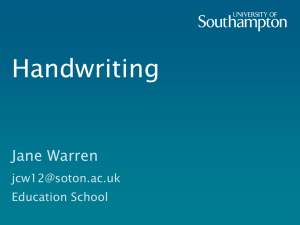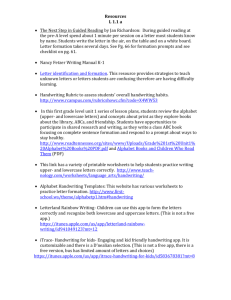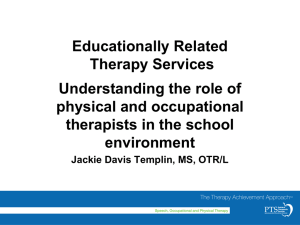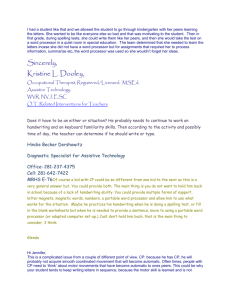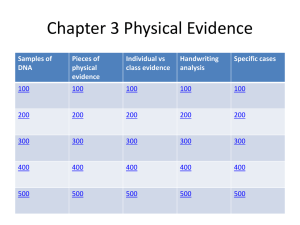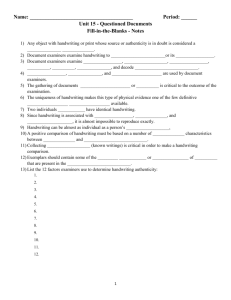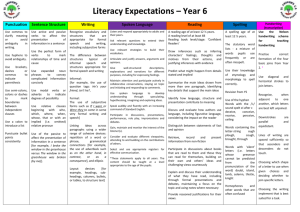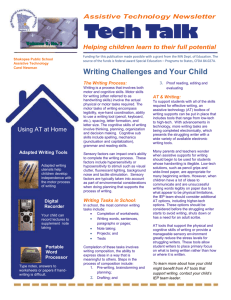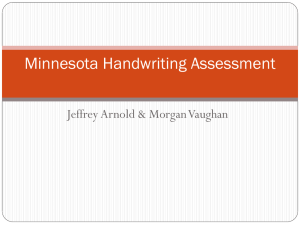Co-odination Difficulties - Oxford Health NHS Foundation Trust
advertisement
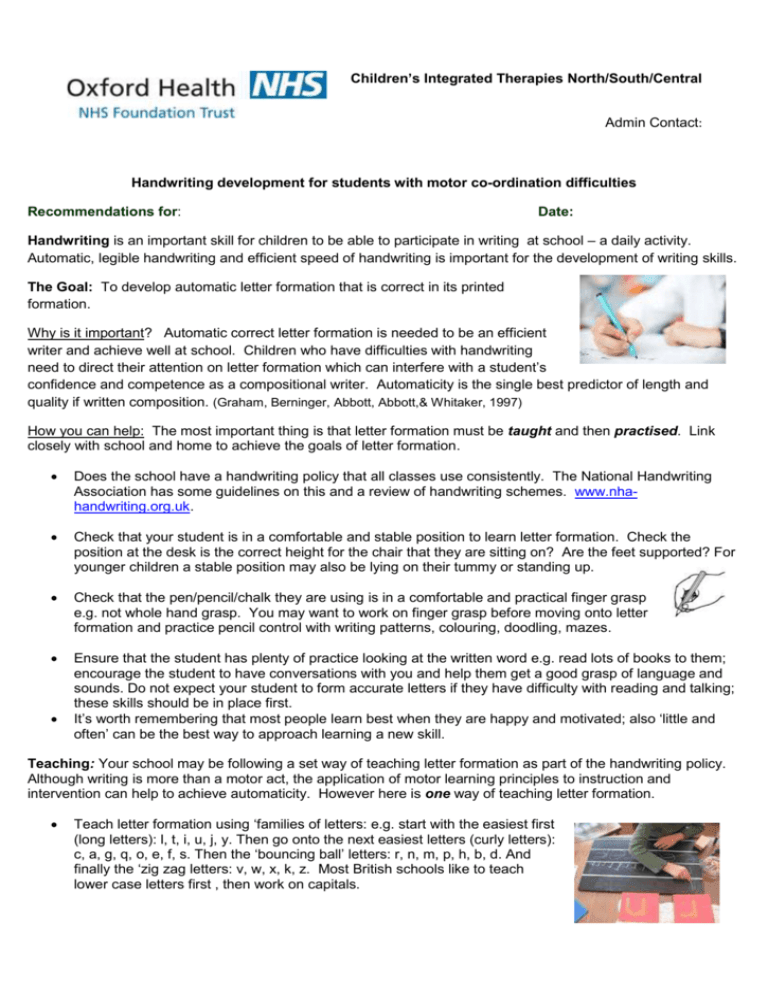
Children’s Integrated Therapies North/South/Central Admin Contact: Handwriting development for students with motor co-ordination difficulties Recommendations for: Date: Handwriting is an important skill for children to be able to participate in writing at school – a daily activity. Automatic, legible handwriting and efficient speed of handwriting is important for the development of writing skills. The Goal: To develop automatic letter formation that is correct in its printed formation. Why is it important? Automatic correct letter formation is needed to be an efficient writer and achieve well at school. Children who have difficulties with handwriting need to direct their attention on letter formation which can interfere with a student’s confidence and competence as a compositional writer. Automaticity is the single best predictor of length and quality if written composition. (Graham, Berninger, Abbott, Abbott,& Whitaker, 1997) How you can help: The most important thing is that letter formation must be taught and then practised. Link closely with school and home to achieve the goals of letter formation. Does the school have a handwriting policy that all classes use consistently. The National Handwriting Association has some guidelines on this and a review of handwriting schemes. www.nhahandwriting.org.uk. Check that your student is in a comfortable and stable position to learn letter formation. Check the position at the desk is the correct height for the chair that they are sitting on? Are the feet supported? For younger children a stable position may also be lying on their tummy or standing up. Check that the pen/pencil/chalk they are using is in a comfortable and practical finger grasp e.g. not whole hand grasp. You may want to work on finger grasp before moving onto letter formation and practice pencil control with writing patterns, colouring, doodling, mazes. Ensure that the student has plenty of practice looking at the written word e.g. read lots of books to them; encourage the student to have conversations with you and help them get a good grasp of language and sounds. Do not expect your student to form accurate letters if they have difficulty with reading and talking; these skills should be in place first. It’s worth remembering that most people learn best when they are happy and motivated; also ‘little and often’ can be the best way to approach learning a new skill. Teaching: Your school may be following a set way of teaching letter formation as part of the handwriting policy. Although writing is more than a motor act, the application of motor learning principles to instruction and intervention can help to achieve automaticity. However here is one way of teaching letter formation. Teach letter formation using ‘families of letters: e.g. start with the easiest first (long letters): l, t, i, u, j, y. Then go onto the next easiest letters (curly letters): c, a, g, q, o, e, f, s. Then the ‘bouncing ball’ letters: r, n, m, p, h, b, d. And finally the ‘zig zag letters: v, w, x, k, z. Most British schools like to teach lower case letters first , then work on capitals. A student will not know how to form a letter by just looking at it; so it is essential to show them how to form the letter first – modelling: o Use letters with arrows and/or other visual cues if possible to guide the correct starting point, direction and finishing point. Ensure that the student forms the letter correctly and does not just ‘copy’ a letter. o Use consistent verbal instructions about the formation of the letters whilst demonstrating to the student and encourage self talk - a well recognised learning strategy to guide formation. o Use a verbal mnemonic or rhyme to sequence the correct order of strokes (the student may come up with a memorable mnemonic of their own that is helpful for them for more tricky letters) o Give the student specific and immediate feedback following an attempt to form a letter; help them to see where they may have made a mistake (so that they don’t practice errors) and also where they were successful. o Encourage self-evaluation of letter formation. Encourage the student to look and see how closely the letter formation matches the target letter, encourage them to circle the best formed letters based on their targets or set criteria. Through guided self-evaluation the student increases their knowledge of results and awareness of the components of legibility. Encourage the student to use this knowledge in other practice sessions o Provide specific feedback on what the student needs to do next time is key to enhancing motor learning o Consistent letter formation instruction is essential for students who may not take to handwriting immediately o Don’t worry about the size of the letters formed to start with; accurate formation is all that matters at this stage. o Move from single letter formation to digraphs and trigraphs, to common words. Dictate common cvc words. Recommended practice 15 – 20 minutes three to five times a week. There are lots of fun and motivational ways to teach letter formation: you can use different materials e.g. crayons, chalks, pastels, and paint; use different paper, and surfaces (e.g. bath crayons, forming letters on steamed up windows, writing letters on someone’s back, writing letters in the air and writing letters with eyes closed). Doodles, fluency patterns, drawing and colouring, and pen and paper games are all good ways of helping a student to develop the skills and abilities needed for letter formation and handwriting. Prior to handwriting encourage the child do some warm ups including….pressing palms together, pulling each finger at the tip, press the palms on to the desk, chair push ups with hands flat on the seat pushing their body up. Useful Resources: Write from the start – Teodorescu Start Write Stay Right Speed Up! (for over 8’s) – Lois Addy Therapist Name: Contact details: mobile/office Children’s Community Occupational Therapist


